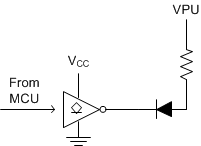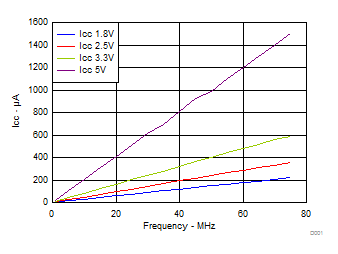SCES307J August 2001 – July 2015 SN74LVC2G06
PRODUCTION DATA.
- 1 Features
- 2 Applications
- 3 Description
- 4 Revision History
- 5 Pin Configuration and Functions
- 6 Specifications
- 7 Parameter Measurement Information
- 8 Detailed Description
- 9 Application and Implementation
- 10Power Supply Recommendations
- 11Layout
- 12Device and Documentation Support
- 13Mechanical, Packaging, and Orderable Information
封装选项
请参考 PDF 数据表获取器件具体的封装图。
机械数据 (封装 | 引脚)
- DBV|6
- DSF|6
- YZP|6
- DCK|6
- DRY|6
散热焊盘机械数据 (封装 | 引脚)
- DRY|6
订购信息
9 Application and Implementation
NOTE
Information in the following applications sections is not part of the TI component specification and TI does not warrant its accuracy or completeness. TI’s customers are responsible for determining suitability of components for their purposes. Customers should validate and test their design implementation to confirm system functionality.
9.1 Application Information
The SN74LVC2G06 is a dual high-drive CMOS device that implements a high-output drive buffer, such as an LED application. This device can sink 32 mA of current at 4.5 V making it ideal for high-drive applications and high-speed applications up to 100 MHz. The inputs are 5.5-V tolerant and let it to translate up or down to VCC. The following Typical Application shows a simple LED driver application for a single channel of the device.
9.2 Typical Application
 Figure 4. Typical Application Diagram
Figure 4. Typical Application Diagram
9.2.1 Design Requirements
This device uses CMOS technology and has balanced output drive. Avoid bus contention because it can drive currents that exceed maximum limits. The high drive also creates fast edges into light loads. Consider routing and load conditions to prevent ringing.
9.2.2 Detailed Design Procedure
- Recommended Input Conditions
- Rise time and fall time specs. See (Δt/ΔV) in the Recommended Operating Conditions table.
- Specified high and low levels. See (VIH and VIL) in the Recommended Operating Conditions table.
- Inputs are overvoltage tolerant allowing them to go as high as (VI max) in the Recommended Operating Conditions table at any valid VCC.
- Recommend Output Conditions
- Load currents should not exceed (IO max) per output and should not exceed (Continuous current through VCC or GND) total current for the part. These limits are located in Absolute Maximum Ratings table.
- Do not pull outputs above 5.5 V.
9.2.3 Application Curve
 Figure 5. ICC vs Frequency
Figure 5. ICC vs Frequency